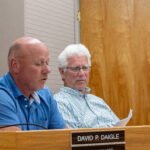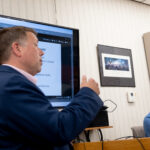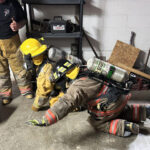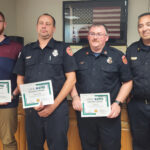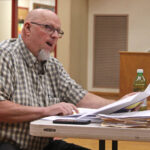By Natalie De La Garza
Staff Writer
NEW SWEDEN, Maine — A new piece of the curriculum has fourth- through eighth-graders working extra hard in their science class the first four days in the week because if they get all their work done, they’ll get to do more science.
Every Friday since the start of the school year, students of Ernie Easter’s science classes have had the opportunity to build and program their own robots using special Lego kits. “We know we’re learning — we’re just having fun in the process,” explained eighth-grader Noah Margeson. “It feels more like playing because …it’s Legos,” he emphasized. “That’s the easiest explanation
The new robotics program at the New Sweden School was formed thanks to the help of two outside entities — a grant through the Perloff Family Foundation, which allowed the school to purchase the Lego robots, and the Educator’s Summer Camp at the Maine School of Science and Mathematics, where Easter and New Sweden’s Teaching Principal Laurie Spooner learn how, exactly, they would be using the robotics.
“Neither of us really knew anything about the robotics, and we came back having a pretty good fundamental understanding of what to do and how to program,” Easter said, noting that the building piece came easy to the two educators but the programming aspect was a bit more challenging.
Introducing the robots into the classrooms started by having students build “basic” three-wheeler type robots — and the first programming challenge was making the robots travel around a square by themselves. Following weeks, Easter would put a challenge up on the board every Friday and students would be charged with programming their robots to stop, or turn around, or programing them to turn around when they hit a wall.
Easter is confident in saying the robotics program has been consistent every week, “because the kids wouldn’t let me miss a week,” he said with a laugh — and all seriousness. “Instead, I get ‘can we do it more often?’”
When sixth-grader John O’Meara first heard about the new science lessons this fall, it grabbed his attention.
“I thought it was going to be an interesting thing, rather than just doing normal science, to be doing something different,” he said. “I expected it was going to be easier and a lot less hands on stuff — more like a toy than an actual learning device.”
O’Meara and Margeson were paired up to work on a robot together, which seemed to be working out well; Margeson likes the building, O’Meara likes the coding, and they agreed that they’ve both gotten better at .
Their first robot was “simple,” as Margeson called it.
“They’re calibrated to do one thing, but it’s usually just for the motor itself and not for the whole robot, so there’s a little bit of weight on there and it’s going to throw it off a bit — so you have to get it right to the precise settings,” Margeson explained, making it sound pretty easy.
Make no mistake, the robotics work is challenging and both Margeson and O’Meara said they’ve been frustrated at different points — but they both agree they’re much better at it than when they started.
When it comes to teaching the fourth- and fifth-graders, sometimes Easter has to change his lesson plan.
“There’s an incredible amount of math that goes along with this, and the math is, at times, a higher level than fourth and fifth-graders normally see,” the teacher described. For example, in January the students were measuring distance by the numnber of rotations the motors of their robots made — which meant students had to figure out the circumfrance of the wheels.
“And if you’re doing it by time, you know that if you go ten feet in ten seconds, you have one foot per second … but if I increase or decrease my speed, what will that do to the amount of distance I follow?” Easter said with a great big smile. “These are some of the challenges they’ve been doing over the past few weeks — that’s hard math.”
He’s even had to teach the younger robotic techs a whole piece on decimals because some of the math requires calculating down to the hundredth.
Earlier this year, when Dave and Sandy Perloff visited the school to see the progress on the robots, they noticed that there weren’t enough robots and some work groups were three-to-a-robot.
“They sent us two more kits,” Easter said. Then the school bought four more, and neither the students nor the robots are showing any signs of slowing down any time soon. There’s no question in Easter’s mind that the robotics lessons are a perfect fit in his classroom.
“Higher level math, problem solving, the whole aspect of ‘think like an engineer,’” he said. Thinking like an engineer — where the answer isn’t as simple as right or wrong — has been a new experience for the youths.
If a robot doesn’t complete its programmed motions — it’s not the same as a wrong answer. It means that robot has to go back into the engineering cycle. “They have to tweak it, and adjust it, and maybe now it works; maybe it takes ten or more times to get it through that cycle — and that learning has been really interesting for many, many of the kids,” Easter said.
When they’re writing programming, for instance, sometimes four different groups working to supposedly write the same program will come up with four different ways of making the robots do the same things.
“That’s huge for these kids to know; they’re as right as their neighbor, even if they have a different answer,” said Easter.
But the benefits of the robotics course extend beyond the science classroom; Spooner teaches math to the same students, and she’s noticed a pretty significant change.
“When we’re talking with circles and degrees and all of those sorts of things as part of math, that’s all common language with them now,” Spooner said. “They understand these things and we’re not taking much time in math to cover these topics.”
Presque Isle, ME
73
Clouds
Houlton, ME
65
Clouds
Caribou, ME
70
Clouds
Fort Kent, ME
72
Clouds
Change Location
- Presque Isle
- Houlton
- Caribou
- Fort Kent
© 2024 Bangor Publishing Company.

